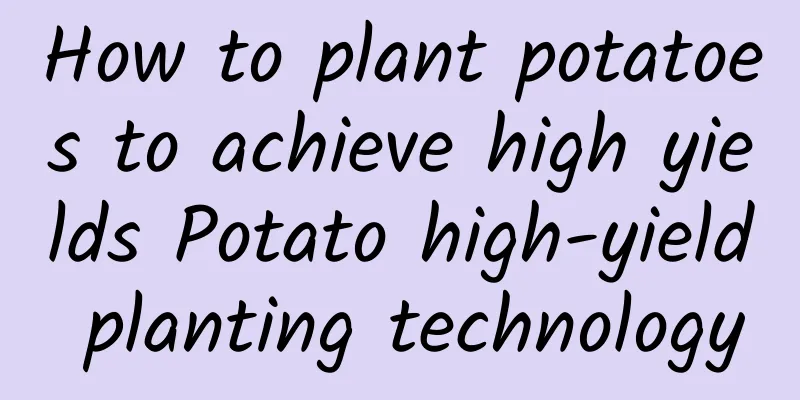How to plant potatoes to achieve high yields Potato high-yield planting technology

|
Potatoes are a crop with extremely high yield per mu, and are also one of the most common cash crops grown by farmers in my country. So how can we grow potatoes to achieve high yields? Potato planting timeUnder normal circumstances, the planting time of potatoes is roughly between February and May in spring . In most areas, the planting time of potatoes is concentrated around March in spring. In areas where the spring warms up quickly and the temperature is high, it is more appropriate to sow potatoes in February and March . If it is in areas such as the Northeast where the climate is relatively cold in spring, the time for sowing generally needs to wait until April or May , when the weather becomes warmer and the temperature rises and stabilizes. How to grow potatoes for high yieldVariety selectionChoose high-yield virus-free seed potatoes that have early tuber formation, fast tuber expansion, short dormancy, moderate maturity, and strong disease resistance. In addition, when choosing varieties, you must consider the depth of the buds. The future development trend is to use mechanical peeling, so you should choose varieties with shallow buds. Seed potato selectionWhen potatoes are propagated by tubers, first choose seed potatoes with smooth surfaces and bright colors. Secondly, choose whole potatoes that are free of insect pests, rodent pests, disease spots, and rot as seed potatoes. Plot SelectionChoose soil with medium to high fertility, sandy loam, loose soil, thin plow bottom layer, deep tillage layer and good drainage for planting. It is strictly forbidden to choose clay plots with heavy soil. Land preparationIn autumn, deep plowing should be carried out to a depth of about 25 cm to loosen the soil. After deep plowing, harrow the soil in time to make the land level. There should be no clods, stones, or root stubble. Nutritious fertilizer should be applied while preparing the land. To avoid repeated potato planting, crop rotation should be implemented, at least every two years to prevent the occurrence of soil-borne diseases. In addition, crushed bitter almonds can be spread during ploughing to prevent underground pests. Cut into piecesWhen cutting, you should take advantage of the top bud and use a sharp knife to cut spirally towards the top bud. Finally, divide the top bud into two or four parts, and each piece of seed potato should have 1 to 2 buds, but no more than 3 buds. At the same time, avoid using the bottom buds for cutting. Generally, about 150kg of cuttings are required per mu. To prevent infection, roll a layer of grass ash after cutting, and then dry the cutting edge. GerminationAbout ten days before sowing, place the cut potato pieces under diffuse light for 1-2 days to germinate. They can also be placed in a room with a temperature of 18-20℃ for germination, and the buds are 2-3cm long. Wait for the buds to turn green or purple and thicken before sowing. It is strictly forbidden to soak them in water during the germination process, otherwise the potatoes will rot. sowingWhen the ground temperature at 10cm above the ground is stable at 5-7℃ and the air temperature is stable at 12-15℃ within five days, it can be planted. When sowing, it should be considered that the entire growth period of potatoes is in a relatively cool and low temperature season to facilitate the formation and expansion of tubers. Generally, furrow sowing is adopted. The sowing depth should be controlled between 6-8cm, the distance between potatoes should be kept at about 25-30cm, the planting density should be 3800-4300 plants/mu, and the soil should be covered after sowing and suppressed in time. Check the holes and replantAfter the seedlings emerge, check the seedlings in time, and replant the missing seedlings and broken ridges in time to ensure full seedlings. When sowing, the remaining tubers can be buried in the field for replanting. Special attention should be paid when replanting: If rotten pieces are found in the missing holes, the missing holes and the surrounding soil should be dug out first, and then replanting can be carried out. Cultivation and soil cultivationAbout one month after seedlings emerge, the first tillage and weeding are carried out at a depth of 8-10cm. This is mainly to weed and loosen the soil. Generally, the second tillage is carried out after an interval of 10-15 days. In addition to weeding, the soil should be cultivated with a depth of about 15 cm and a height of about 8 cm. When buds appear, carry out the third intertillage and soiling , with the soiling depth not less than 12cm. Deep planting and deep covering are truly achieved, so that the potato layer soil is loose and aerated. At the same time, it is necessary to ensure the nutrients and water required for potato growth, which is conducive to root growth and increases yield. Harvest at the right timeThe plant stops growing, most of the stems and leaves turn yellow, the tubers are easily separated from the stolons, the layers become hard, and they can be harvested in time. |
<<: The role and use of rooting agents 8 methods and recipes for making your own rooting agents
>>: How to grow a potted banyan tree well? How to grow a banyan bonsai tree more vigorously?
Recommend
How to grow carnations during their flowering period
1. Lighting It likes to grow in an environment wi...
How to care for and water Phalaenopsis?
Phalaenopsis orchids are widely loved for their e...
How to water and fertilize fuchsia
1. Fertilization method Fuchsia likes fertilizer....
Does the camellia tree prefer shade or sun?
Does the camellia tree prefer shade or sun? Camel...
Cultivation method of tree monkey iron orchid
1. Soil The tree monkey orchid prefers relatively...
What flowers are suitable for planting on Guangzhou balconies? Flowers suitable for planting on southern balconies
What flowers are suitable for planting on Guangzh...
What causes orchid leaves to turn yellow?
Orchid is a plant that requires careful care. Alt...
Cultivation methods and precautions of copper coin grass
1. Flower soil The pennywort is suitable for grow...
Can expired milk be used to water flowers directly? The correct way to water flowers with expired pure milk
Can expired milk be used to water flowers directl...
What are the breeding methods and precautions for cranes?
How to breed cranes Crane plant is a plant of the...
Characteristics of Bougainvillea varieties
Bougainvillea is easy to reproduce and grows fast...
Cultivation methods and precautions of yellow bract arrowroot
1. Maintenance methods 1. Temperature: Caladium g...
What flowers are easy to grow and suitable for indoor cultivation (flowers suitable for long-term indoor cultivation)
Speaking of indoor flower growing, in fact, many ...
How to plant red seeds
1. Cutting Outdoor planting can be done in June o...
How to sow peach blossoms?
1. Sowing time Peach blossom sowing is usually ca...









